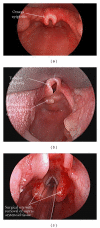Laryngomalacia: disease presentation, spectrum, and management
- PMID: 22518182
- PMCID: PMC3299329
- DOI: 10.1155/2012/753526
Laryngomalacia: disease presentation, spectrum, and management
Abstract
Laryngomalacia is the most common cause of stridor in newborns, affecting 45-75% of all infants with congenital stridor. The spectrum of disease presentation, progression, and outcomes is varied. Identifying symptoms and patient factors that influence disease severity helps predict outcomes. Findings. Infants with stridor who do not have significant feeding-related symptoms can be managed expectantly without intervention. Infants with stridor and feeding-related symptoms benefit from acid suppression treatment. Those with additional symptoms of aspiration, failure to thrive, and consequences of airway obstruction and hypoxia require surgical intervention. The presence of an additional level of airway obstruction worsens symptoms and has a 4.5x risk of requiring surgical intervention, usually supraglottoplasty. The presence of medical comorbidities predicts worse symptoms. Summary. Most with laryngomalacia will have mild-to-moderate symptoms and not require surgical intervention. Those with gastroesophageal reflux and/or laryngopharyngeal reflux have symptom improvement from acid suppression therapy. Those with severe enough disease to require supraglottoplasty will have minimal complications and good outcomes if multiple medical comorbidities are not present. Identifying patient factors that influence disease severity is an important aspect of care provided to infants with laryngomalacia.
Figures
References
-
- Richter GT, Thompson DM. The Surgical Management of Laryngomalacia. Otolaryngologic Clinics of North America. 2008;41(5):837–864. - PubMed
-
- Thompson DM. Abnormal sensorimotor integrative function of the larynx in congenital laryngomalacia: a new theory of etiology. Laryngoscope. 2007;117(6, supplement):1–33. - PubMed
-
- Richter GT, Wootten CT, Rutter MJ, Thompson DM. Impact of supraglottoplasty on aspiration in severe laryngomalacia. Annals of Otology, Rhinology and Laryngology. 2009;118(4):259–266. - PubMed
-
- Thompson DM. Laryngomalacia: factors that influence disease severity and outcomes of management. Current Opinion in Otolaryngology and Head and Neck Surgery. 2010;18(6):564–570. - PubMed
-
- Cohen SR, Desmond MS, Eavey RD, May BC. Endoscopy and tracheotomy in the neonatal period. A 10-year review. Annals of Otology, Rhinology and Laryngology. 1977;86(5):577–583. - PubMed
LinkOut - more resources
Full Text Sources
Medical


